The Sokos are a tiny cluster of uninhabited islets south of west Lantau.

Even as Korean farmers are staging a diversionary action on Hong Kong Island [Dec 2005], Nick “the Civet” G and I stand on a pier on Cheung Chau, about to play our role in sabotaging a facility to the west.
A call to my mobile, and our vessel dodges by the main pier, berths, and we board, joining the other members of our crack team – one of whom has grown a huge beard as disguise.
Nearing the exit to the typhoon shelter, the skipper guns the engines, and we’re off!
Destination: the Soko Islands (索罟群島).
Mission: scupper plans for a liquified petroleum gas (LPG) terminal. [Note – added September 2008: China Light and Power has announced that it has cancelled plans for the terminal, after the government reached an agreement with the mainland re gas supplies. Hooray!!!]]
We bounce over the choppy waters of the South China Sea, passing close by Shek Wu Chau, outpost for recovering drug addicts; from the boat, there’s no sign of the statues and pool modelled on ancient Rome. There’s a stretch of open sea, with Zhuhai islands to the south, Lantau Peak appearing a perfect broad cone to the north.
We arrive at the Sokos. At the first island, there’s a new pier, with a road leading away, to low hills. As we slow, and the roar of the engines abates, team leader Richard W – ace financier and modern mariner – tells us these were built for a radioactive waste facility, which the government built “without telling anyone”. I’m with the others in the team in thinking this was clearly wrong.
On round a headland, there’s a small but lovely beach, with the remains of a small typhoon shelter. We moor here, for a key part of our mission: having a look around and taking photos.

The water’s fairly clean; in summer, this would be a pleasant place to moor a junk, and swim.

There’s a small shrine by the beach, well maintained – by former villagers we assume – and painted a brilliant red. (No one lives on the Sokos now; at least some of the former residents moved to Cheung Chau.)
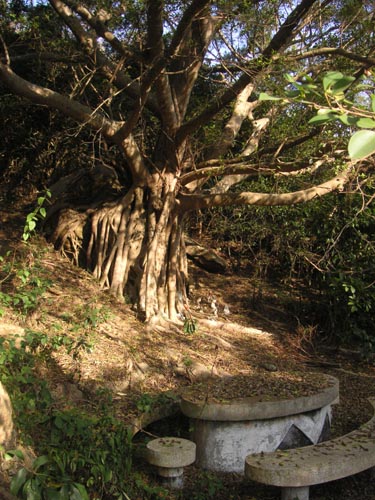
Richard doesn’t let us linger; but guides us up a narrow path through the trees, passing this fine banyan with small statues at its base. We walk reverently to the tree, and join hands as we give it a warming, group hug (or, really, take photos).
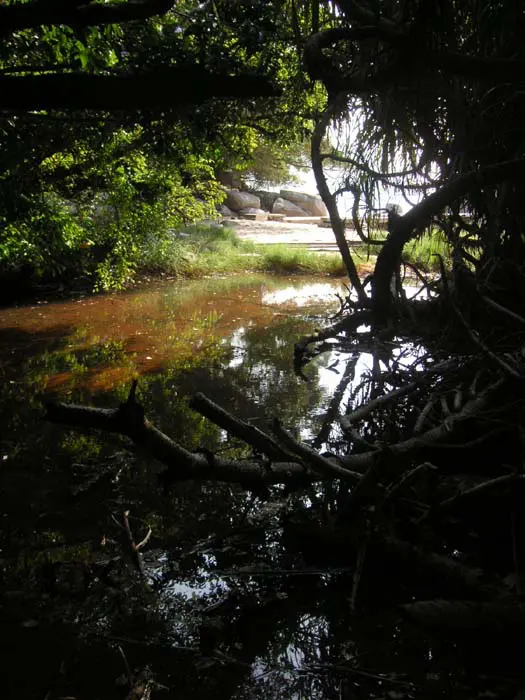
A creek flows to the beach, forming a small pool overhung by a tangle of trees.

Back to the boat, a short ride, and we’re alighting again, this time to the largest of the Sokos – Tai A Chau. There’s another pier here, close by the area once occupied by a detention centre for Vietnamese refugees. “Watch for Chinese dolphins – they’re often here,” says Richard as we approach. No dolphins today, though.

Again, Richard’s the man with the plan, and we go yomping along more old trails he knows, passing through woodland (not many native trees; many acacias, it seems).

There’s a lovely, quiet pool, with woodland and sky reflected in the still water. Chestnut Bulbuls – forest birds, in Hong Kong mainly found around Tai Mo Shan – call from the trees: these individuals are probably winter migrants.
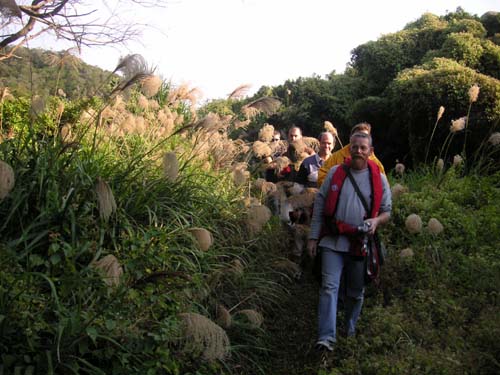
The team has assembled through the Living Islands Movement, which played a major role in battling the planned superprison on Hei Ling Chau (the plans were shelved). Looks to me as if we’re what one radio presenter might suggest are Westerners Against Development, tho it turns out one guy, at least, was born in Hong Kong and speaks Cantonese.

After our intrepid band is stopped by a small swamp, we take another route, up and over, and arrive at a small beach, where – as it faces the northeast monsoon – the tideline is covered in bits of wood, and lap sap including polystyrene. Sad, really; this should be a lovely beach, the kind of place turtles might nest.
There are chunks of dead coral, too – so living hard corals can’t be far away. (“In Soko Islands, the corals [faviids] were mostly confined within a narrow zone between –1m to –2mPD. In 1997, however, a 100% mortality of all these corals was reported [6, 7]. The reason for this is unknown. No quantitative data was available for coral cover in all these sites.” – Conservation of Hong Kong corals)

From the beach, the team starts heading off round the coast – climbing a giant boulder with precipitous sites, or scrambling up through trees and onto rough grassy slope and over a ridge. Me, I’m all for going back the easy way, but the guy in front of me decides he’s going up the slope and says he’s 71, so it’s the hilly route for me, too.
From the top of the hill, there’s a vantage over the bare expanse of concrete where the refugee camp used to be. A pair of White-bellied Sea-Eagles soars over the hill; one is clutching a stick, so maybe they are beginning an early nest.
A mixed flock of Crested Mynahs and at least 20 Red-billed Starlings swirls over, landing in trees and on rocks by the concrete. The mynahs are common; but the starling is a globally near-threatened species, occurring in Hong Kong in winter, mainly in the Deep Bay area (I’ve lived on Cheung Chau for 18 years, never seen one there, so a surprise on the Sokos, tho I have seen small numbers at Pui O on Lantau).
US biologist Dr James Lazell reckons this would be a fine place for an ecotourism resort. Looks good to me, too; these islands cold make a lovely base for someone wanting a night or more “away from it all” yet readily reached from urban Hong Kong.
But this place would be transformed if we don’t succeed in our mission to halt ideas for an LPG terminal here. This is [was] one of two possible sites suggested by China Light and Power.
Nor is the LPG terminal the only environmental insult mooted for the Sokos – there are also ideas for a landfill (for waste disposal) just to the west.

Here’s the beach just by the former refugee detention area; very tranquil, with a small temple the only building here (just hidden by trees here).
It’s not just Dr Lazell and our team who figure the Soko Islands are ecologically significant; a Southwest Lantau and Soko Islands Marine Park was proposed in 2002; and in March that year, Thomas C Y Chan, Director of Agriculture, Fisheries and Conservation, noted in written response to govt finance committee, “We have already started the procurement process for the patrol launch and the speed boat. The two marine parks at southwest Lantau and Soko Islands are expected to be designated in late 2002 or early 2003.”
Alas, this proposed marine park has not materialised. Instead, the threat of the LPG terminal hangs over the Soko Islands. {Happily, cancelled in Sept 2008]
During today’s mission, we’ve found this small cluster of islands – Tai A Chau, Siu A Chau and a smattering of islets and rocks – is a wonderful place, which could indeed be the centre of a fine marine park, with potential for ecotourism.
Now, it’s time to blast back across the waters south of Lantau.
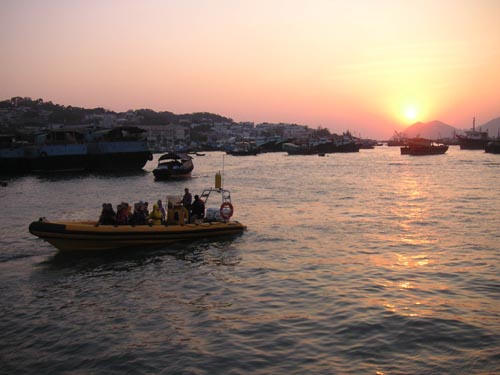
Nick and I alight at Cheung Chau, and as the sun sets the Yellow Peril takes the team off for the next stage in the mission Richard has carefully planned: a meeting at the pub, to discuss what to do next. Would-be Sokos wreckers, take note, and tremble.
A Low Level Radioactive Waste Facility opened on Siu A Chau in June 2006.

 The Sokos are a tiny cluster of uninhabited islets south of west Lantau.
The Sokos are a tiny cluster of uninhabited islets south of west Lantau.














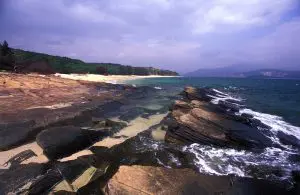
Soko Islands revisited inc Tai A Chau
Went to the Sokos today, with landing on Tai A Chau. Little changed; and seemed we were the only people on Tai A Chau (maybe there were fishermen on rocky coast, but it was like our own island for the time we were there).
Here's a view to a sheltered beach. Had a swim here. Not a fabulous beach; but Hey – it was a summer Sunday, and there was no one else there.
Pool still there; rather more overgrown. Looks to me like it could be a nice little nature reserve…
Here's the low-level radioactive waste facility (not fully built during visit described above), at south of Siu A Chau.
Soko Islands in 1974
neat film showing life on the islands in 1974:
http://www.dailymotion.com/video/x2p426b
Hi Martin,
This is excited to find your blog about Tai A Chau, I am a post-graduate student in Urban Environments Design in POLYU, I have a big interest in exploring the ecosystem in Anthropocene, including human\’s intervention towards natural ecosystems and how to design for non-humans in this era (After I arrived HK, the current director of our alumini expressed this design perspective and philosophy, I began to perceive things based on non-human creature\’s perspective and their well-beings) it is different with many design schools around the world). I choose this island for my capstone research and design site- for restoring its ecological values and its potential for self-autonomy, as a contradictory voice against human\’s intervention for this dessert island.
I went to the island a week ago and I have not seen as much as you did, But I also observed many marine waste, garbages on the beach, the building waste that still detorrirating the island\’s seashore. Due to these days is been in the rainy season, I have seen a lot of butterflies and insects on this island, my research tutor want a specific scope and very thorough approach for my research proposal, so I am going to start the survey based on butterflies ( Ecologist use butterflies as model organisms to study the impact of climate change, habitat loss and as an ecological indicator of health of the ecosystem). However, my design proposal would not limited for one species assemblage, I would rather to consider the whole island in a holistic view, and its relationship with direct or indirect human impacts. In order to gather as much as possible information, I found your amazing websites, Could you please help me with more details according to your teams visit and observation? I could not agree more that this island has a certain conservation value for endangered species, because I am a student with design background, so it would be fantastic to hear from professional with numerous outdoor experience!
Looking forward to hear from you,
Yenny Li
Hi Yenny:
Thanks for the comment; great you’re doing a project – hope there is a real possibility for plan that can lead to enhancements at Tai A Chau.
I don’t have much more by way of details; never done a proper survey, and it’s some time since I last visited.
Martin